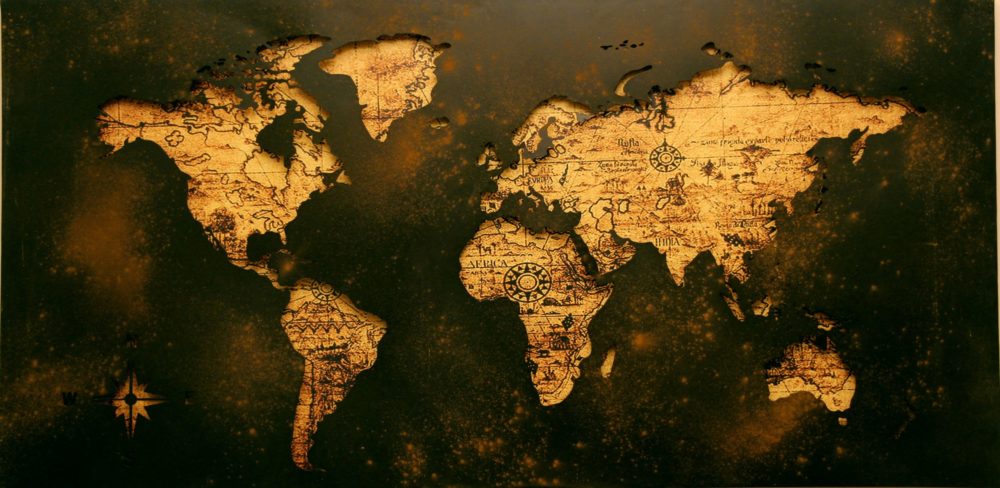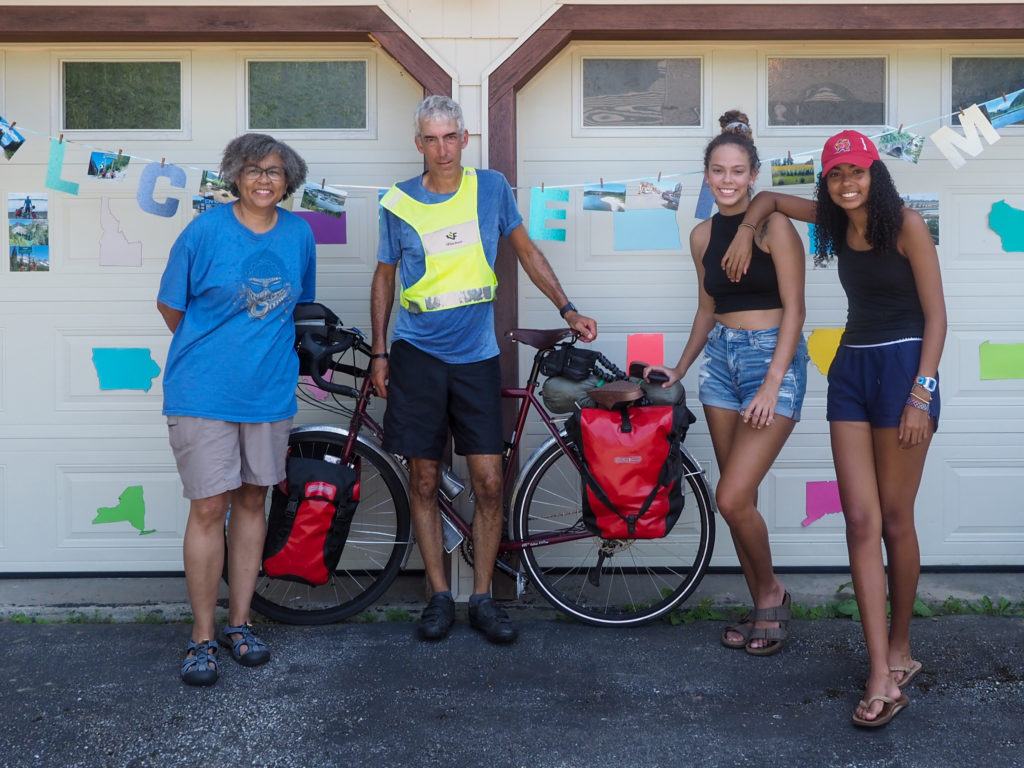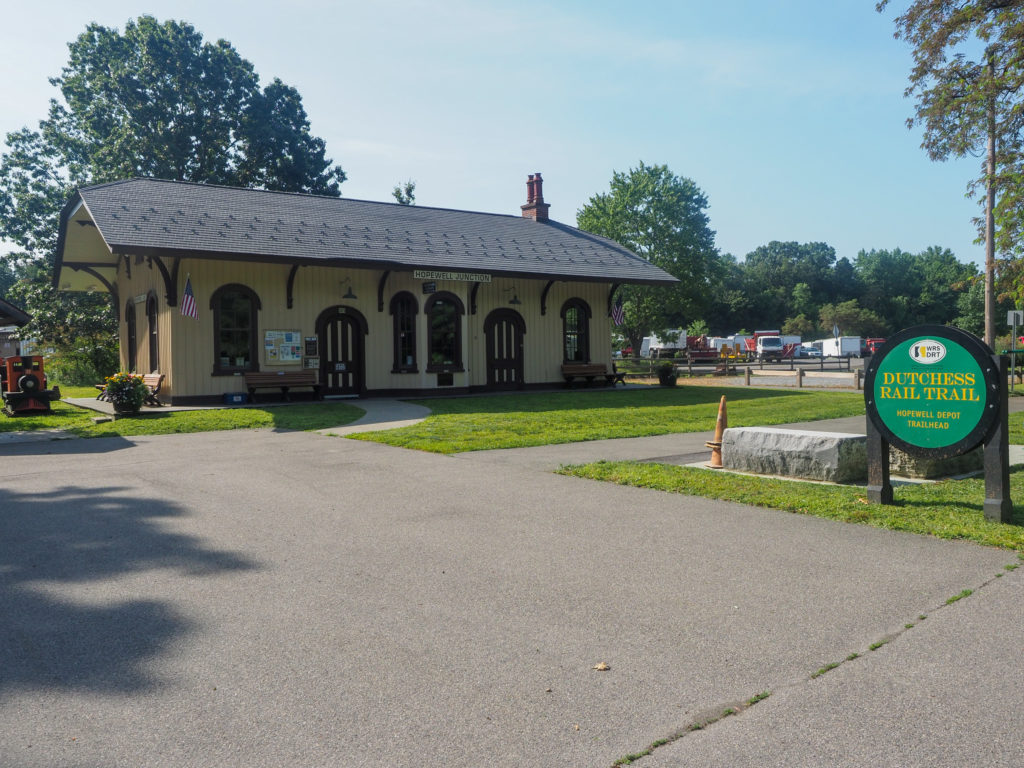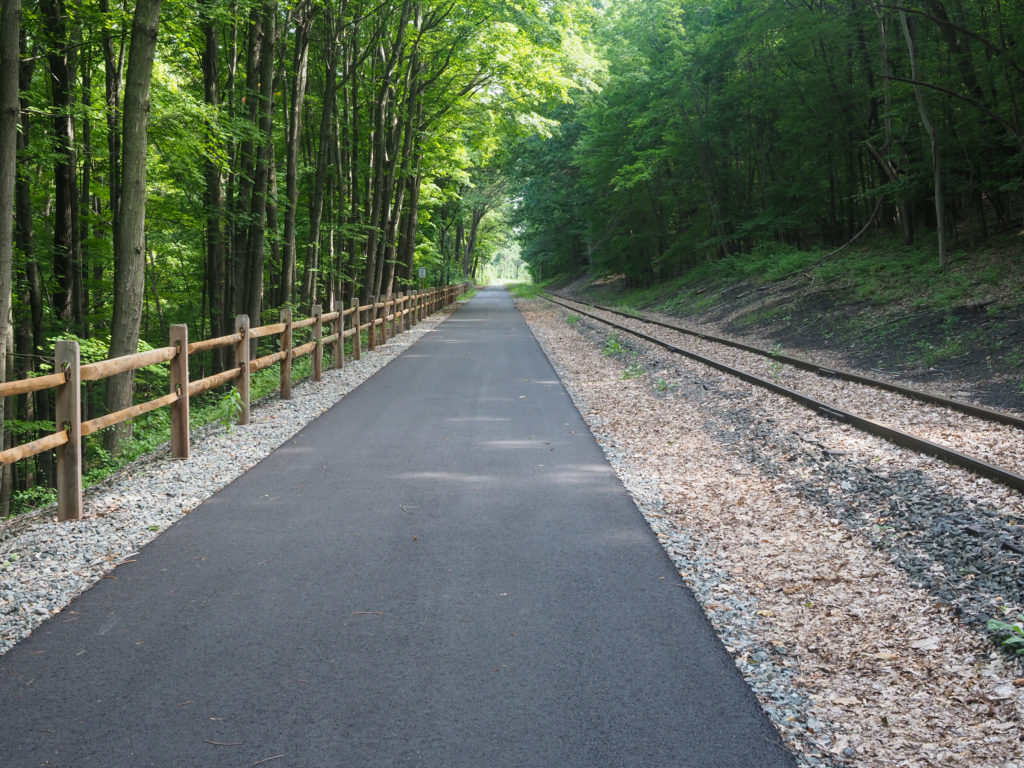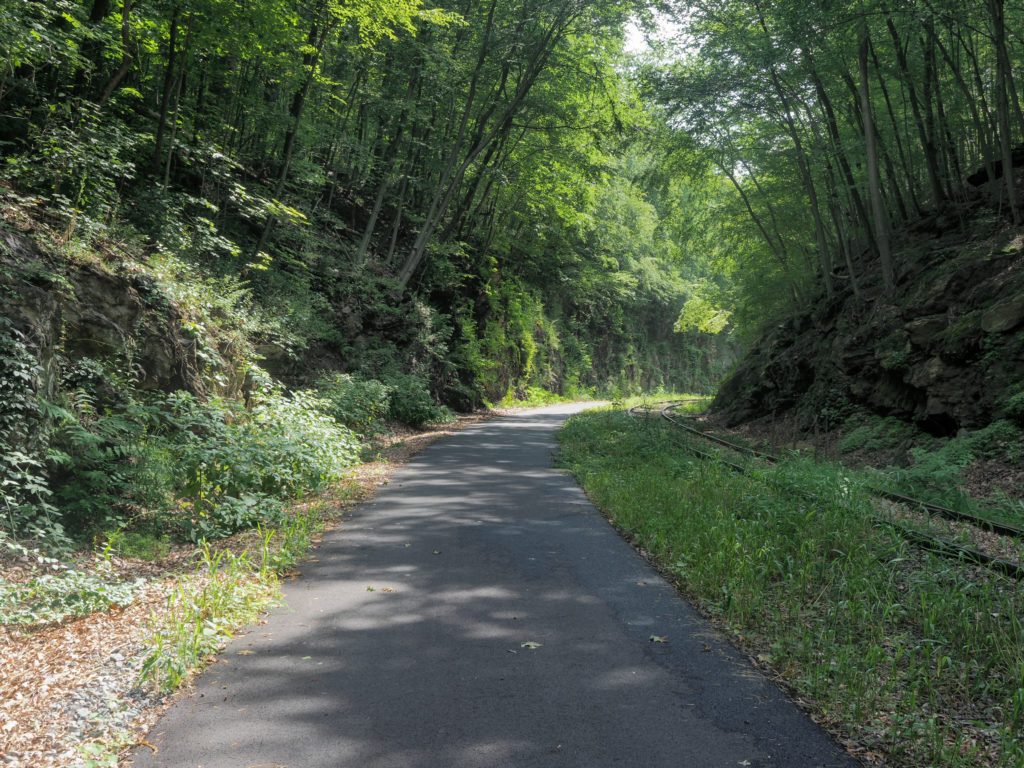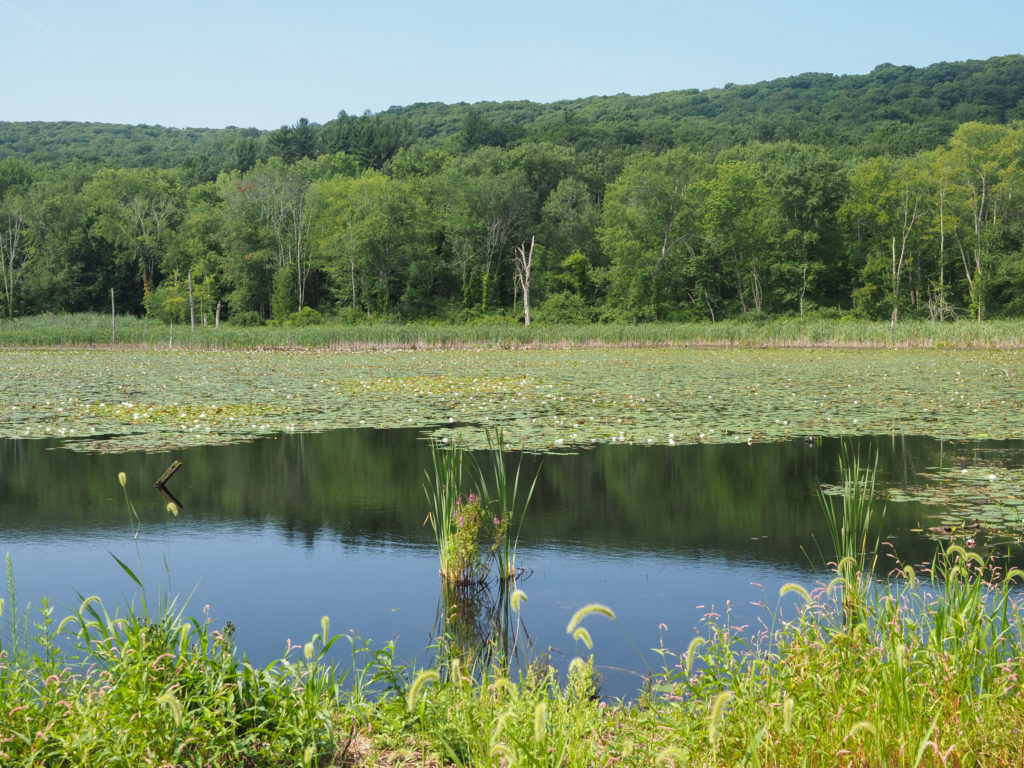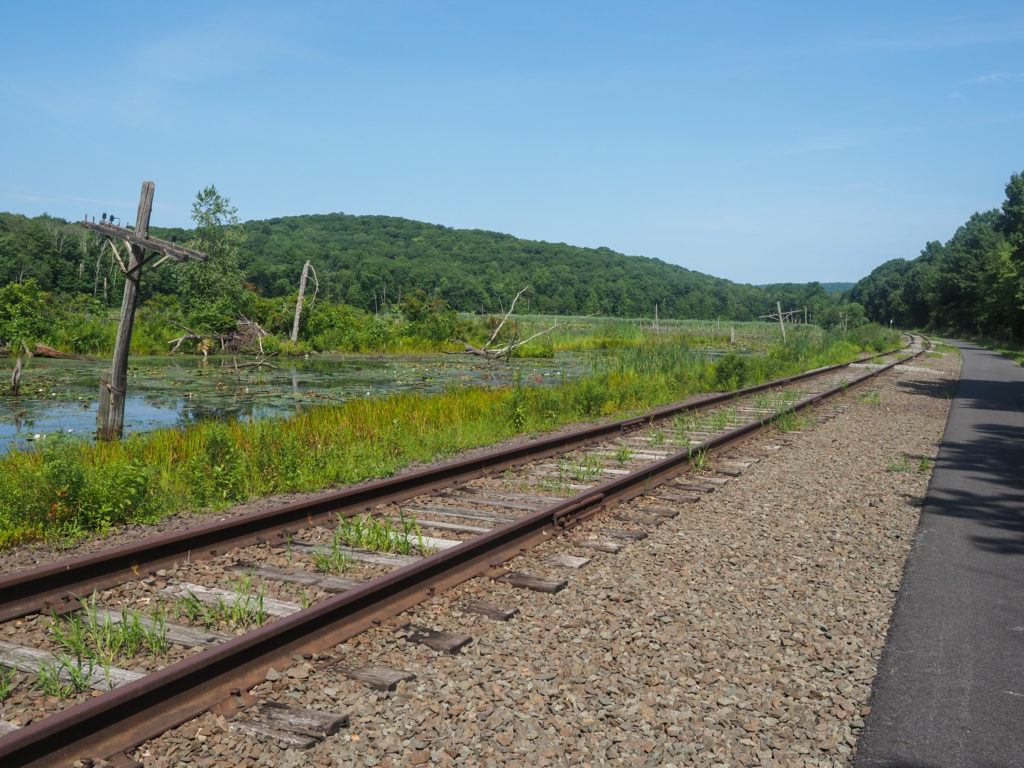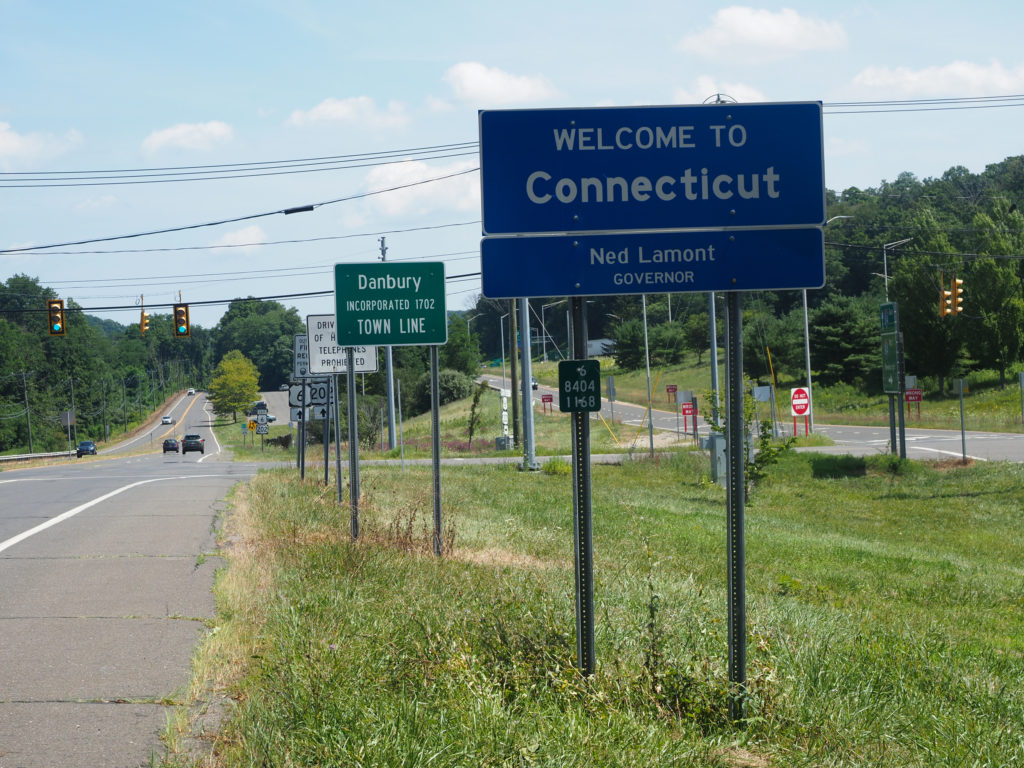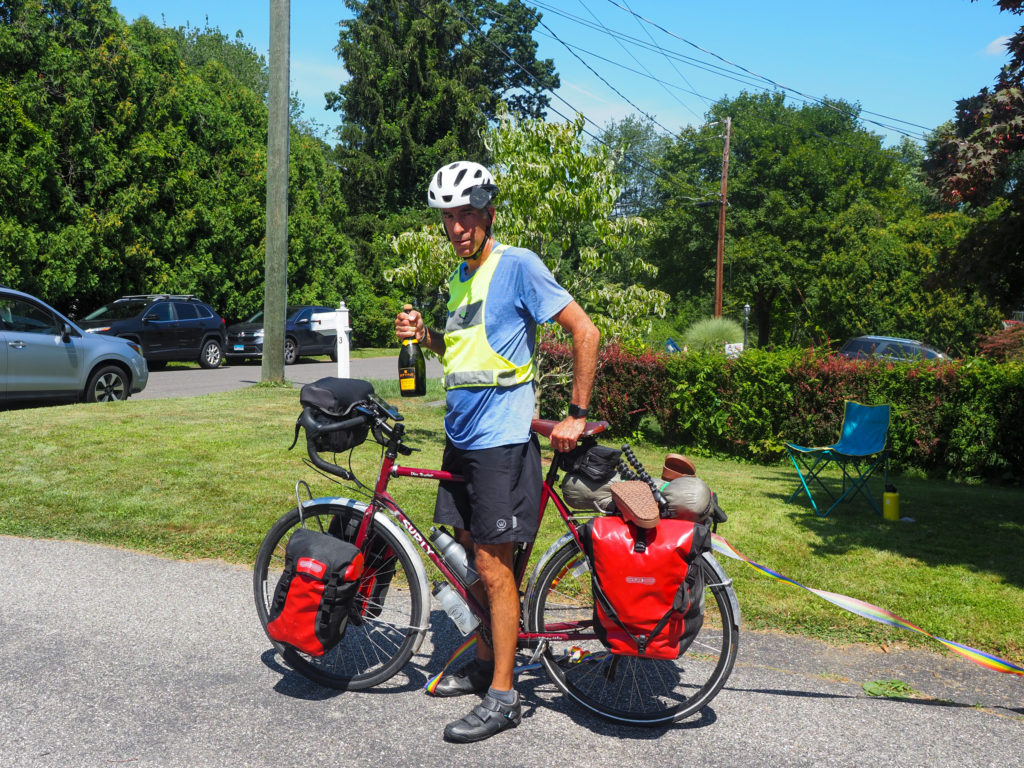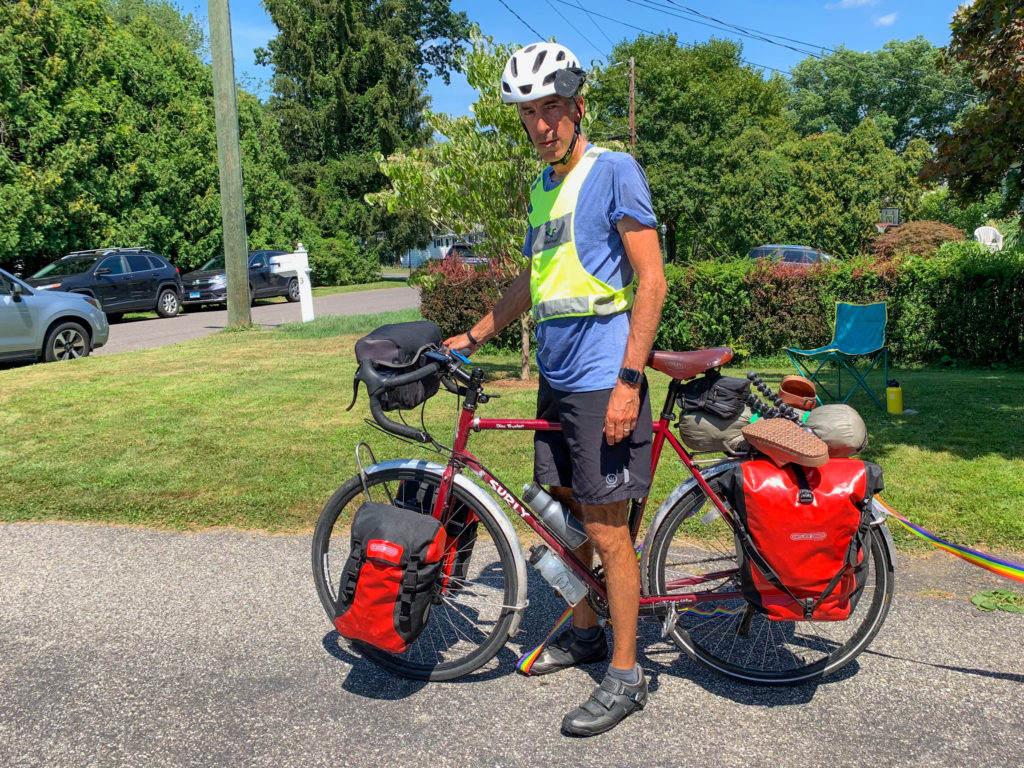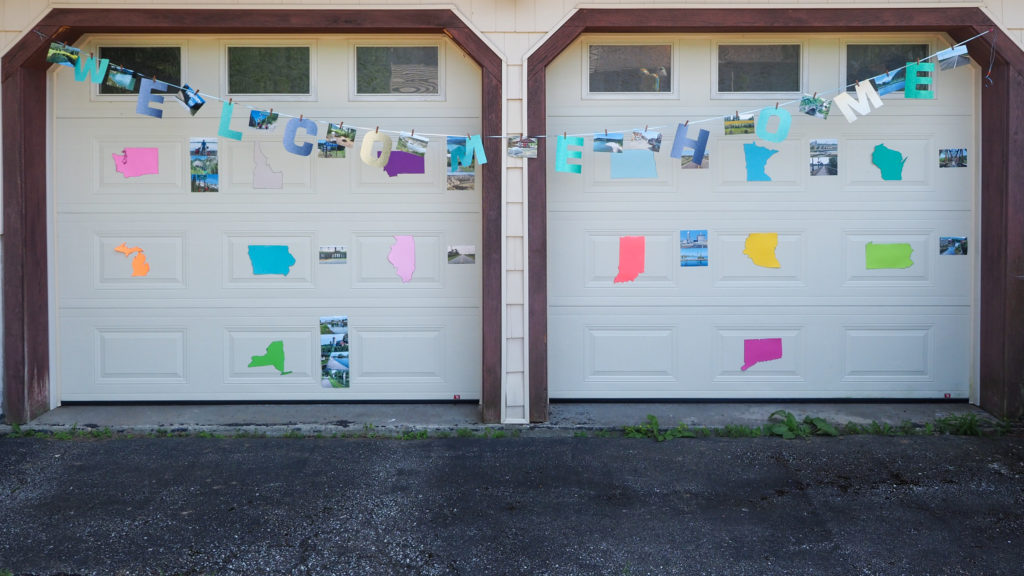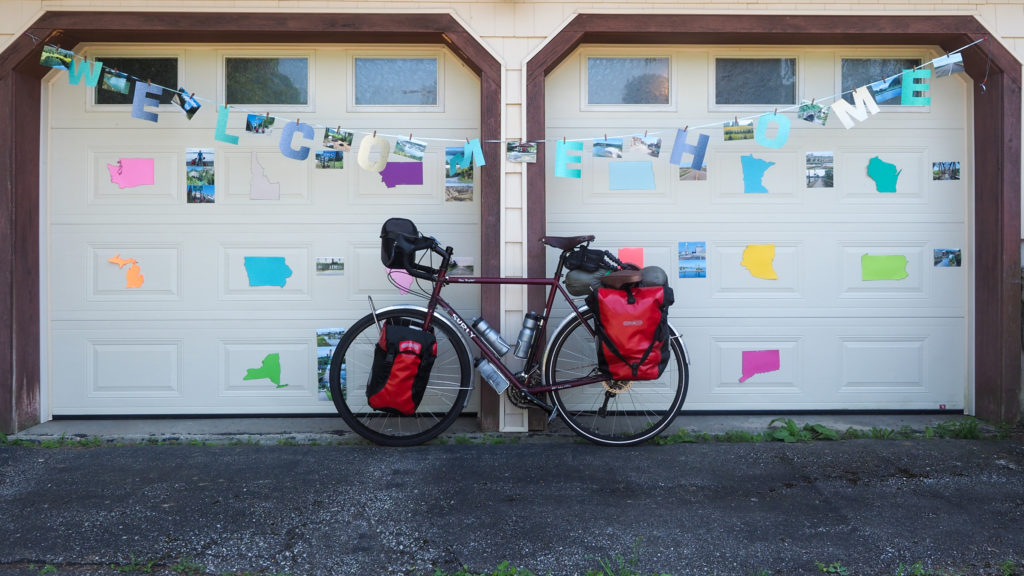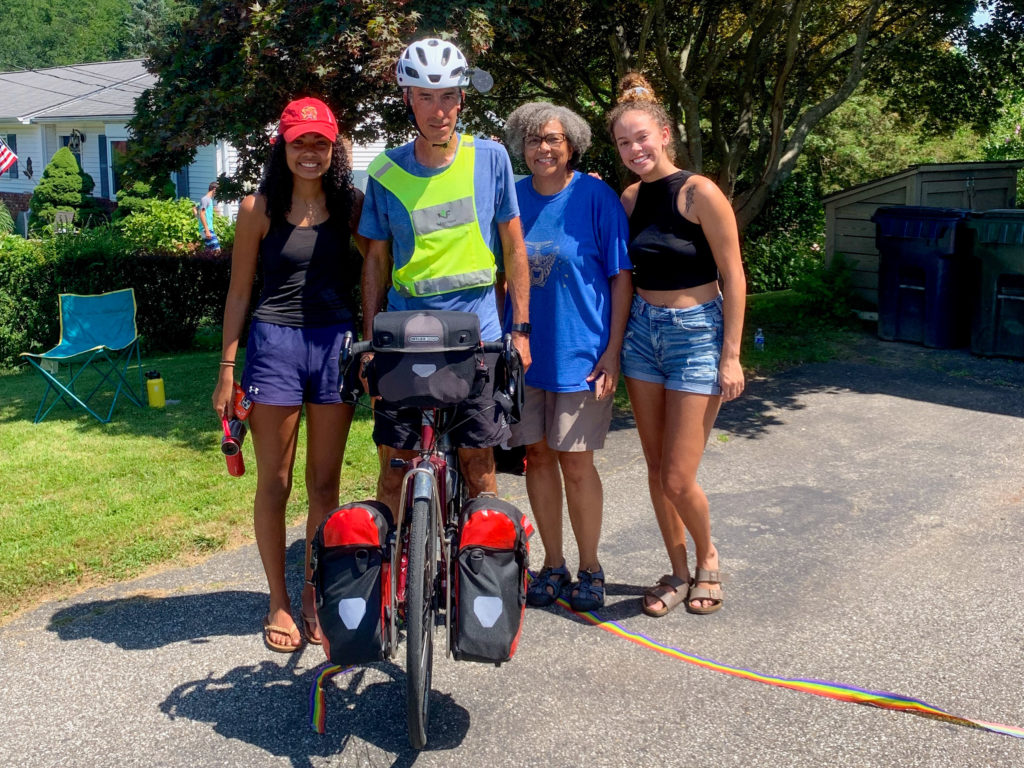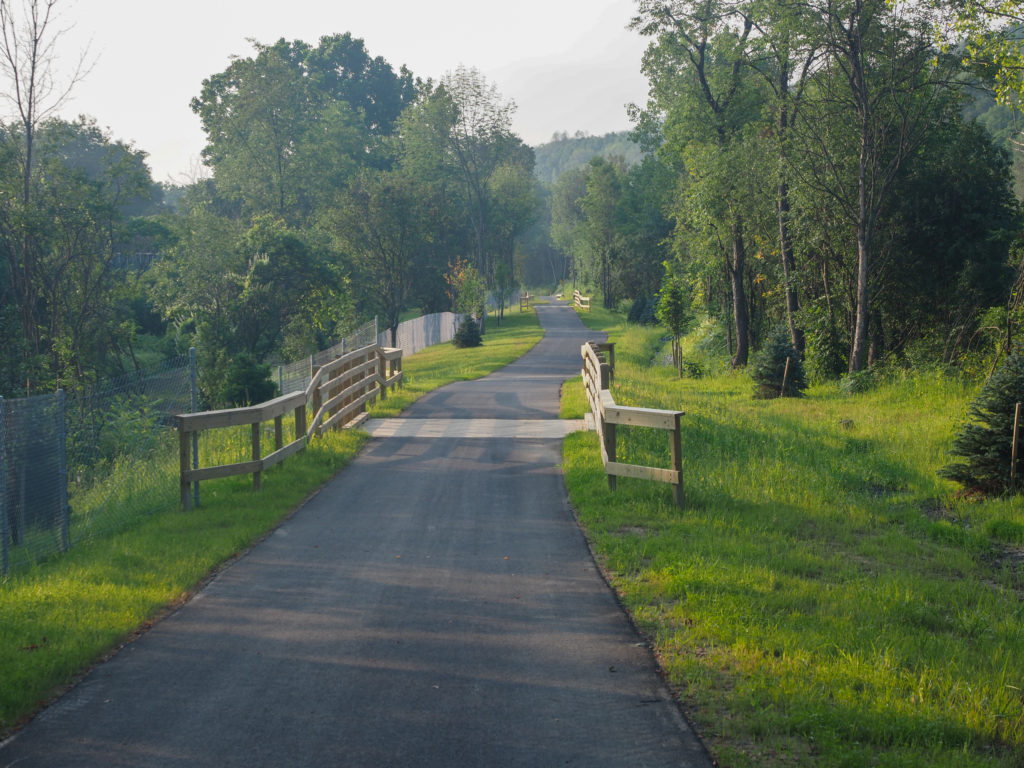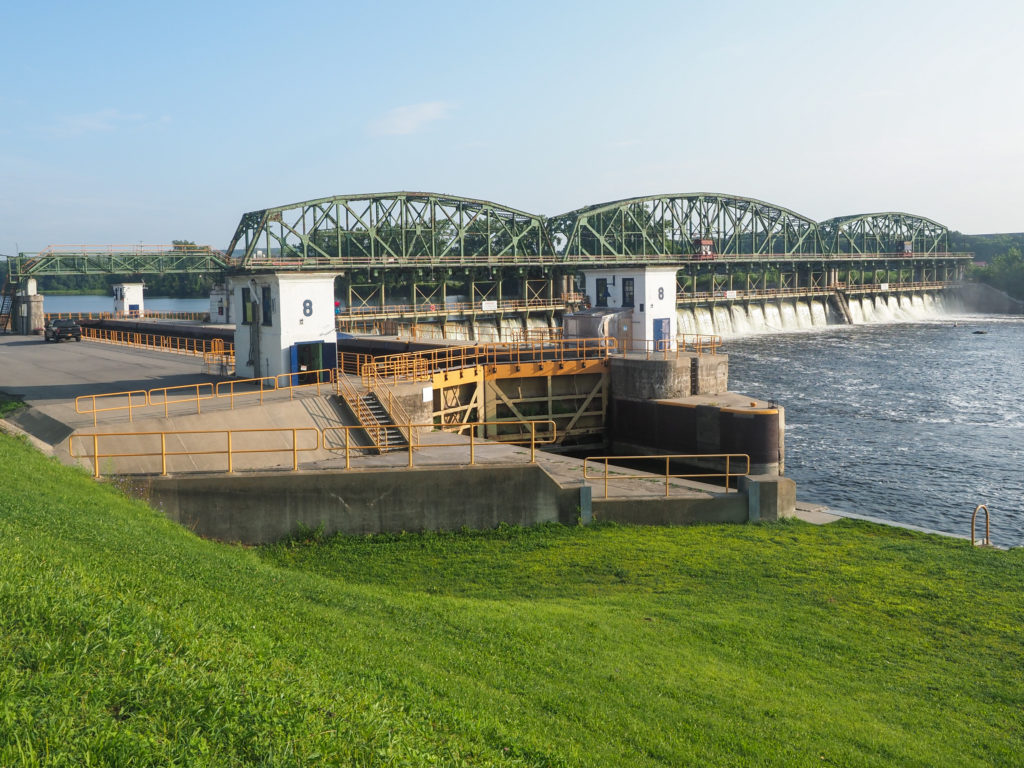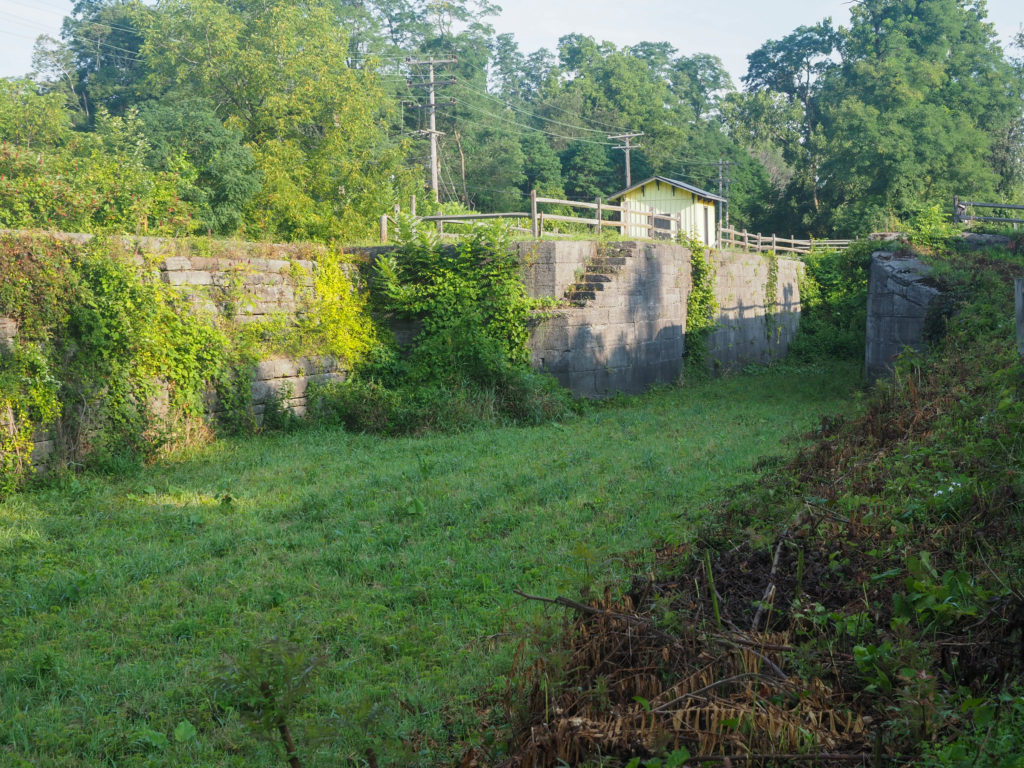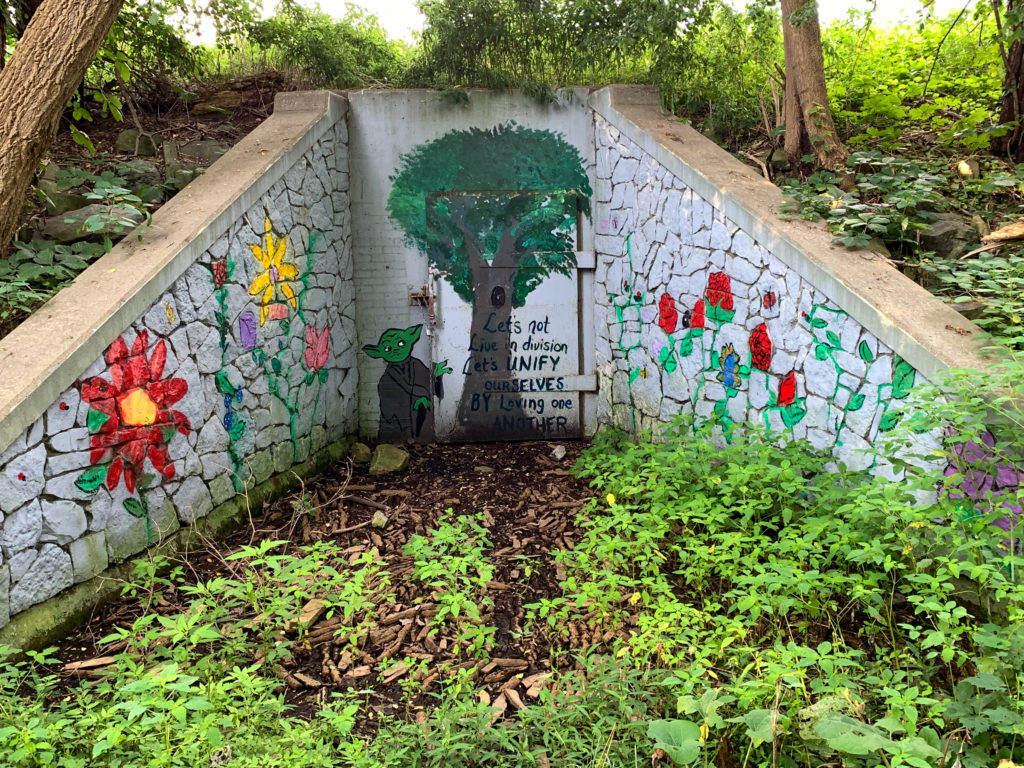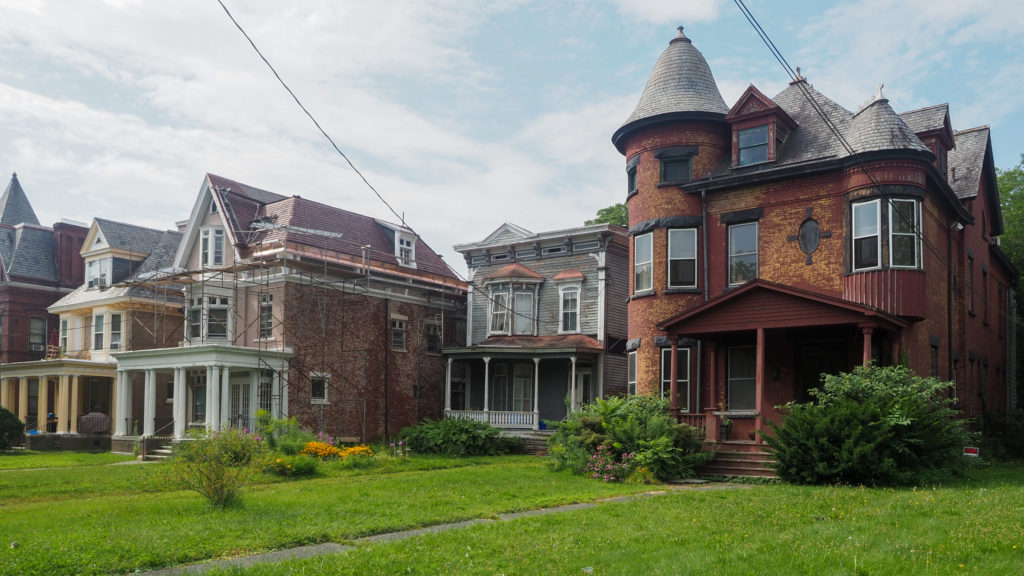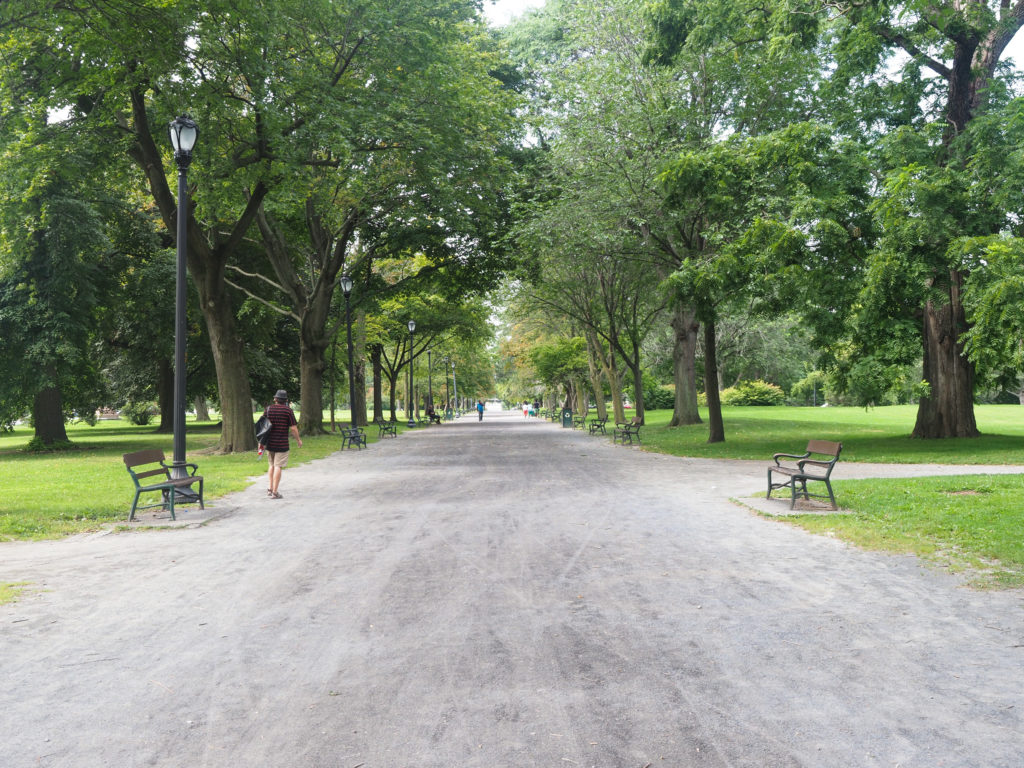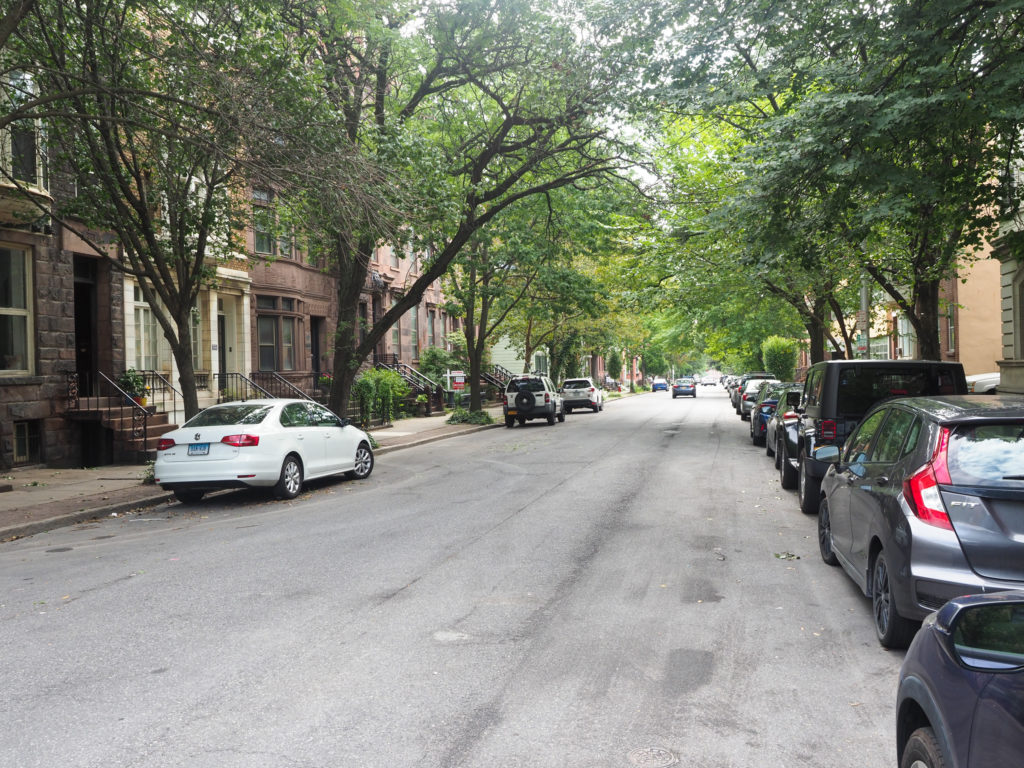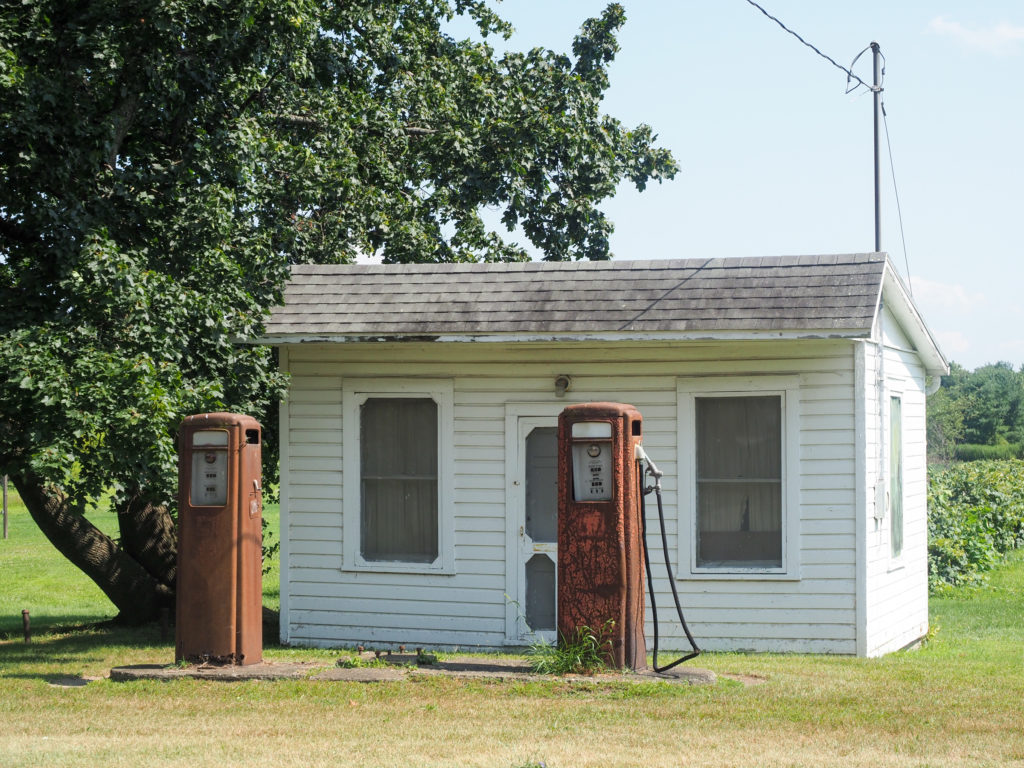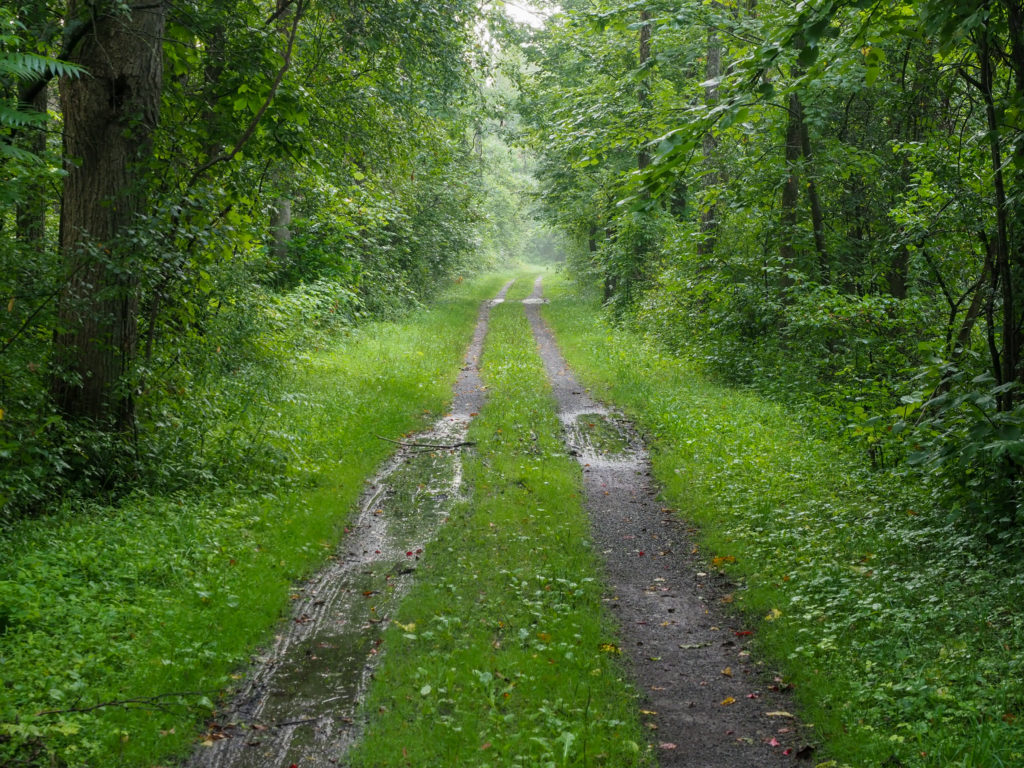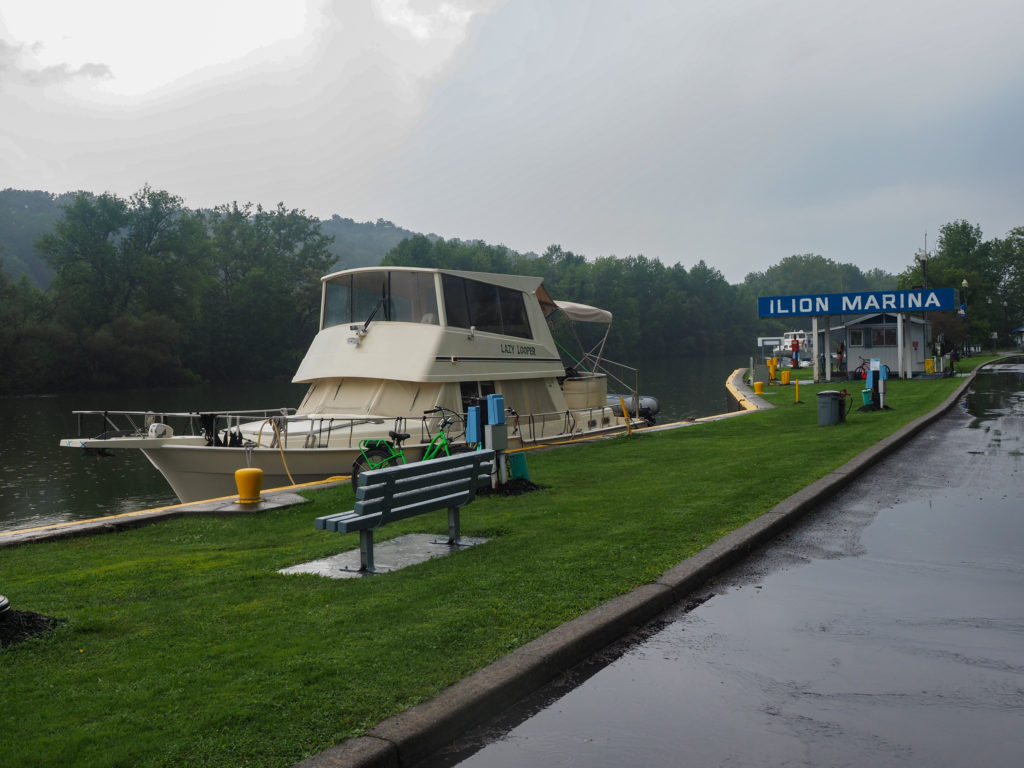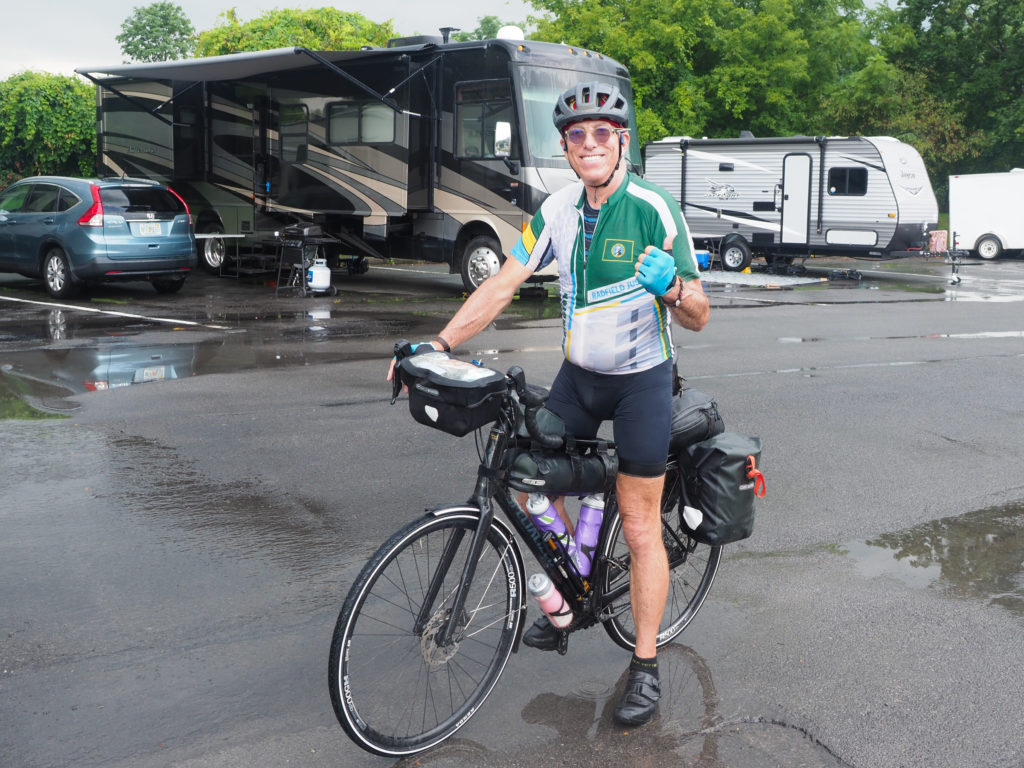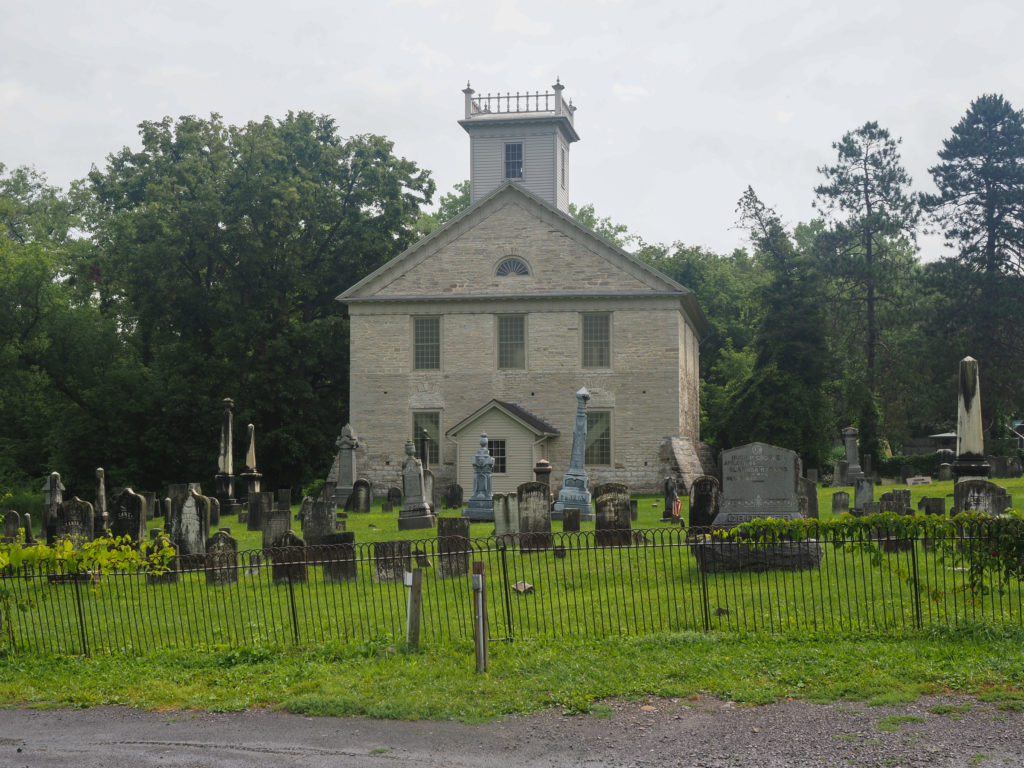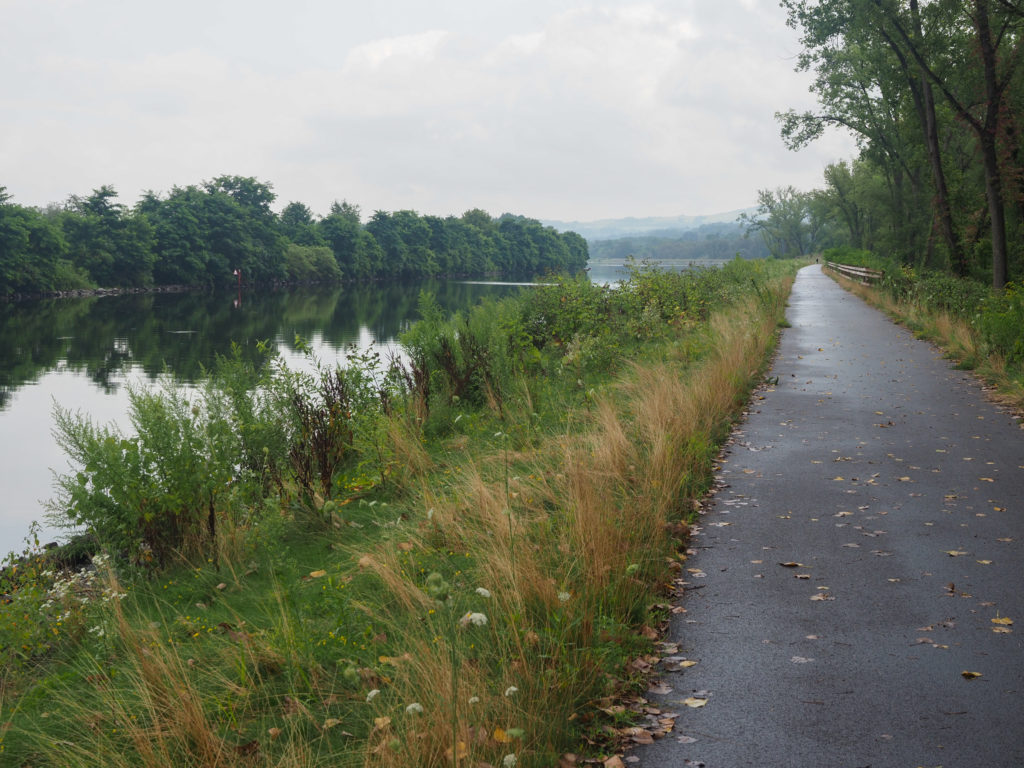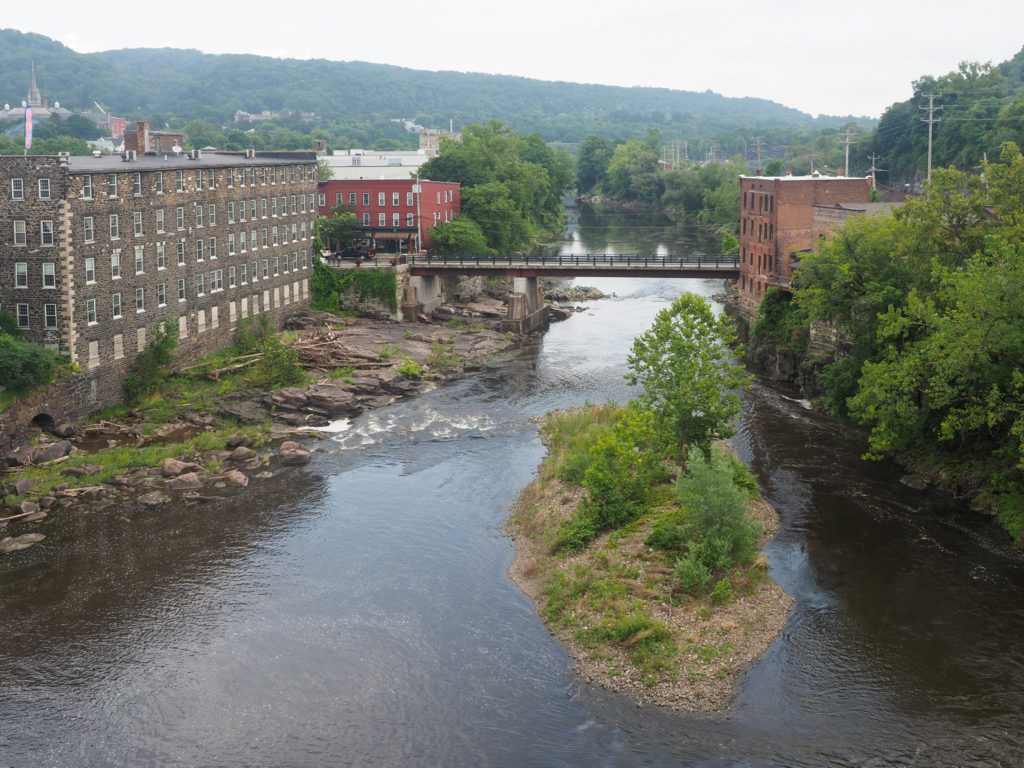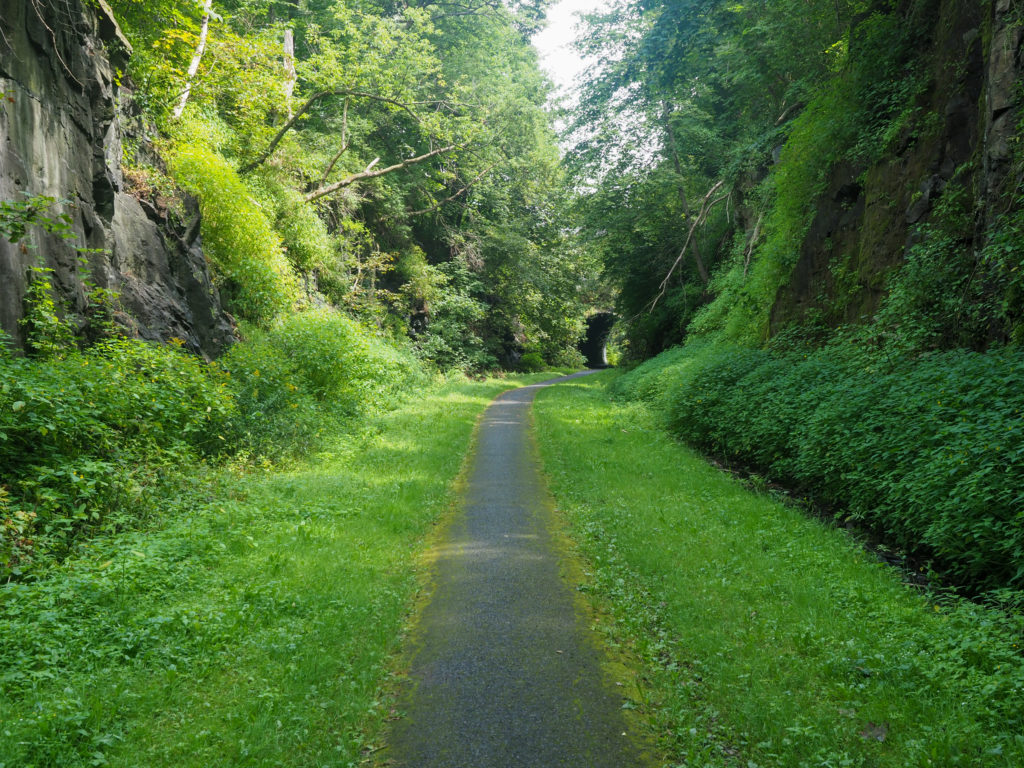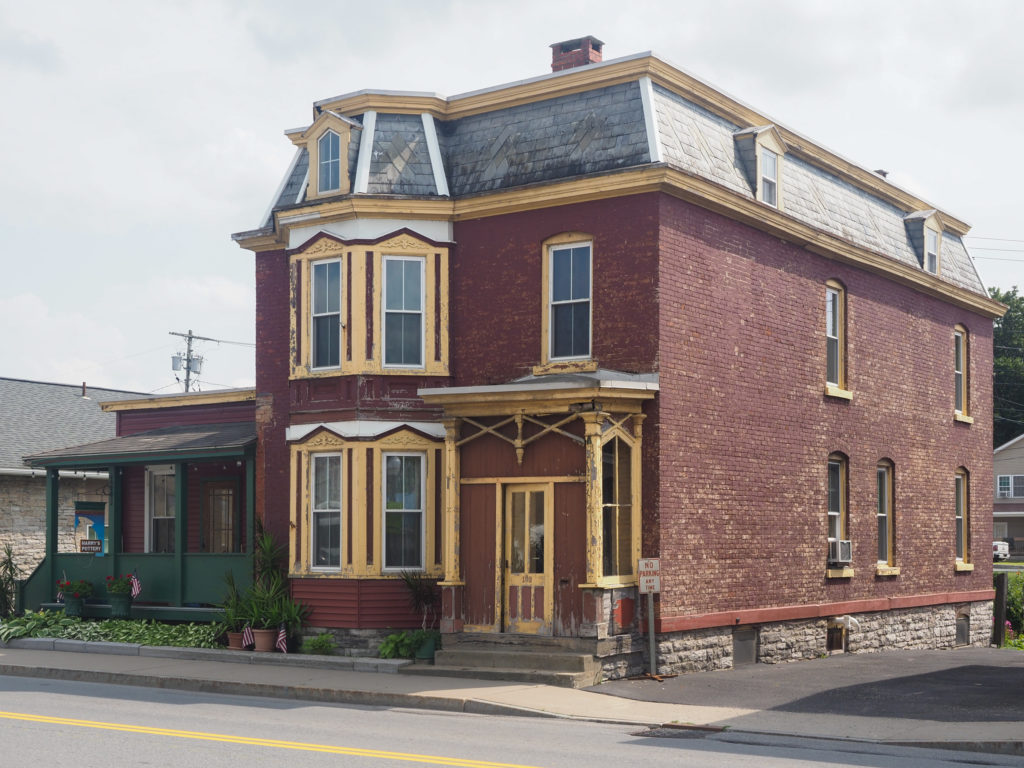My gear review may only be of interest to other cyclists or people curious about some of the specific gear I brought for other purposes like camping. To briefly summarize, I was happy with my gear choices. I definitely could have paired down and brought less but I used almost everything I brought. The real decision is between camping or motels, then how ultralight you want to be. I camped far less than intended so my camping gear didn’t get much use. You can definitely do this trip without camping but it takes more planning. The majority of cyclists I met were camping but I met more than a few who were only staying in motels.
Most cyclist were carrying 4 panniers, front and back. Some just had rear panniers while others were using a more bike packing configuration without panniers using a frame bag, seat pack, and handlebar roll. I initially thought bike packing was a dopey way to travel since it’s kind of trendy now but the advantage is reduced wind profile so I would seriously give this configuration some thought. The wind worked against me all tour with headwind almost every day so a reduced wind profile would have made my ride easier.
The Bike – Surly Long Haul Disc Trucker
The components are stock build circa 2015 so typical Shimano, Tecktro, Avid, and Continental gear with a few additions. I chose Surly because it’s a tried and true touring bike. I stopped at a few bike shops along the way and all made comments like “that’s the bike you want to ride across country”. I saw other Surly’s out there but also a lot of other bikes, many of the usual suspects like Trek, Salsa, and Kona. Don’t feel like you have to shell out a lot of money you don’t have for a “real” touring bike. Many bikes can make the trip if loaded properly with gear. What’s more important is how the bike is geared. You will do some climbing so you want low gears.
The bike worked flawlessly, no problems except for tire wear which is to be expected. I did have an issue that I thought was a failed freehub but was actually the plastic disk between the cassette and spokes which became dislodged, a simple fix.
- Front Racks: Tubus Cosmo
- Rear Racks: Tubus Nova
Not much to say here other than they worked fine.
- Fenders: Velo Orange Hammered alloy
I don’t know why anyone would ride a touring bike without fenders. Sure, they went out of style decades ago but this isn’t a beauty contest or a race. Protecting yourself and your bike from dirt, mud and road debris far outweighs any downside. I’ve heard reasons not to use fenders like “something could get stuck and jam the tire” or “mud will get caked up”, all bullshit. I’m sure it has happened but such concerns really fall into the urban legend category, not likely a problem. Thick mud can be an issue on trails but you would not take a bike configured primarily for roads through a lot of thick mud on a regular basis. Just shut up and get the fenders.
- Pedals: Shimano A530, SPD one side, platform the other so I can ride clipped in, or not.
I really like the reversible pedals. At the end of the day I prefer wearing my running shoes pedaling around town. I see no downside to having reversible pedals.
- Saddle: Brooks B17, classic leather saddle.
For me the Brooks saddle was a compete fail. I broke in the saddle over about 500 miles before the tour and it did feel better with time, was molding to my bottom, but even after hundreds of miles on tour I still was never fully comfortable on the saddle. I need some padding. There’s a lot of lore around Brooks saddles, they are highly regarded in the touring community which I think influences peoples opinions. I can’t say others are not comfortable on a Brooks but I can say a broken in Brooks is still a hard saddle, it just shapes better to your bottom. If you are comfortable on a Brooks you would likely be fine on a range of different saddles. I don’t have a lot of natural padding so I need the bike to supply some. I don’t need or want a big, bulky gel pad but just a little would be good.
Bags
- Front: Ortlieb Front Roller Classic
- Rear: Ortlieb Back Roller Classic
- Handlebar: Ortlieb Ultimate 6 Classic
All worked well. The bags are heavy, weighing in at about 8 pounds empty combined but very durable and waterproof.
Shirts
- Riding t-shirts: 3, just close fitting, active wear t-shirts not cycling shirts. I used synthetic that didn’t smell, some people prefer wool for odor protection.
- Riding button down: a mountain bike variety. Can double as a town shirt
Shorts/pants
- Riding shorts: 3
- Long convertible pants: 1, my only long pants
Socks and underwear
- Socks: 4 ankle length, SmartWool
- Underwear: 4 briefs, Exoffcio
- Padded liners: 3
I could have taken fewer clothes but I was happy with what I had. If I do another trip I’ll probably take the same. My objective was to do less hand washing and more actual laundry every week or so. I settled on a pattern of hand washing my shirts, socks, and padded shorts once each then do laundry every 6th day or so. Padded shorts do not dry overnight so even if you are exclusively hand washing you really need to bring three. I wore regular shorts over my padded shorts to look less like a freaky cyclist when not on the bike like entering businesses and such. I wore the regular shorts 2-3 days and never hand washed, I just didn’t have to. I only used the long pants when camping, for temperature and mosquitos. My plan for the underwear was to wear with the padded shorts one day then the next day without so I didn’t have to hand wash the padded shorts. I think the underwear added to my saddle sores so I eventually stopped wearing them at all while riding, requiring me to hand wash the padded shorts.
Shoes
- Cycling shoes: Shimano Torbal SPD mountain bike shoes
- Off bike shoes: old running shoes
- Sandals: Birkenstocks, Arizona EVA
No problems with the shoes. Taking both sandals and running shoes is not necessary but it worked for me. Running shoes are bulky but weigh almost nothing and I liked wearing them off the bike rather than sandals all the time. I wore the sandals while camping, in public showers, or if I wanted to briefly step out of my room in a hotel. The EVA Birks weigh almost nothing and strapped on to the top of my bags so they took up no space. I would probably take the same three again.
Wet or cold weather
- Rain jacket: North Face.
- Leg and arm warmers: I’m not bringing any long sleeves other than a lightweight hoody and a sweatshirt. I have no long riding pants.
- Shoe covers: mostly for rain or a little warmth if necessary
- Lightweight Hoody: good for cool starts
- Hooded sweatshirt: most likely just for mornings and evenings around camp
I expected colder days/nights in the mountains but that never happened. I sent my leg/arm warmers home after about a week when it was obvious I’ll never need them. I never wore the lightweight hoody which was intended for cool mornings on the bike but it was never all that cool. I wore the hooded sweatshirt while camping and a few nights/mornings going out while in motels. I didn’t need both. It only rained one day on this tour so I didn’t use the rain jacket but I would bring one just in case. I never needed the shoe covers. I would have worn them for all day rain.
Camping
- Tent, Big Agnes Copper Spur HV UL2
Two person really means one person with a little extra room. Worked fine but I wonder about durability with such a lightweight tent but durability is a tradeoff with weight.
- Sleeping quilt, 30 degree Feathered Friends Flicker with Sea to Summit compression sack
I really like a quilt over a traditional sleeping bag. You can open it up into a blanket or zip up and close one end like a sleeping bag. Thirty degrees is cooler than I needed, could have used a forty or fifty degree bag, but better to have too much than not enough warmth. The compression sack reduced the size by about half.
- Sleeping bag liner/sheet: protects the bag and adds some warmth.
I brought a cotton, rectangular, zippered liner which is heavier and adds more weight than a silk mummy but it’s more comfortable. I often started the night with just the liner then covered with the quilt when the temp dropped. I would bring this again even though it’s a little bulky.
- Sleeping pad, Nemo Tensor, a couple inches thick.
Very comfortable but I should have bought the long size.
- Pillow: Sea to Summit Aeros
Super small and light, takes up almost no space packed. Reasonably comfortable for what’s basically an airbag. I primarily used between my knees when sleeping on my side (my typical sleeping configuration).
- Pillow: Nemo Fillo
Similar to regular pillow when inflated. Comfortable but a few times larger/heavier than the Aeros when packed. Not a big deal unless you are going ultralight.
- Camp stove and fuel canister, MSR Windburner 1L
Really just for boiling water for coffee, oatmeal, or heating up canned/packaged food. Worked well but you can’t actually cook on a camp stove. I also used the stove in motels that didn’t have microwave ovens.
Technology
- Laptop: M1 MacBook Pro
- Camera: Olympus EM1 MK2 with 12-40mm lens
I like photography so I wanted to bring a real camera. I brought the laptop for working on photos and publishing the blog. While blasphemy to photographers, if I do another tour I may just use my iPhone. Almost all of the pictures posted to Instagram were taken on the phone with very little editing. I think they were pretty good. Rather than a laptop I would consider an iPad with a keyboard cover or something like a Microsoft Surface if you swing that way. Both would result in a significant weight and bulk reduction.
- Jobby Tripod: My “selfie stick”
Rarely used so I would not bring on a future trip.
- Phone: iPhone XS
My phone was my primary navigation device using either the Bicycle Route Navigator app where I bought the Norther Tier maps or I Google maps.
- Extension cord: 15’, a suggestion from another trip journal.
My intent was to run power to my tent while camping. While I did this a couple times I used it more in hotels running power to a more conventient location. I didn’t need a 15’ cord for hotel use but it is very useful when plugs are hidden. I will now add a short 6’ cord to my standard travel kit.
- Portable charger: 20k mAh
Used everyday but I didn’t need all 20k mAh. My phone only lasted half a day with the GPS logging apps I was running.
- Adventure Cycling Northern Tier maps: because technology often fails
I never needed the physical maps but glad I had them.
- Power strip/surge protector: by Poweriver
My favorite piece of travel gear has always been a small power strip, allows for charging multiple devices from a singe outlet plus some protection from surges. This particular device was larger than needed but I would definitely bring something similar.
- Bicycle Route Navigator app: by Adventure Cycling, my digital maps.
Used almost every day, how I followed the Northern Tier.
Health and Safety
- Repair kit: tools, extra bike bolts, tape, 5’ bailing wire, other stuff
- Leatherman multitool
- Crankbrothers bike multitool
Bike tools are a necessity. I used pliers from my Leatherman a few times to pull wire from my tires. I never needed the extra bolts, bailing wire, tape etc but would definitely recommend bringing, just in case.
- Inner tube and patch kits
I brought one spare tube and a couple patch kits. After getting my first flat (I had 4) I patched the tube and kept it as a spare. After my second flat I bought a new tube and kept one patched.
- Chamois butt’r: to avoid saddle sores
Bring and use daily unless you are confident saddle sores will not be an issue.
- Dual Eyeglasses, sunglass and yellow lens, with bifocal reading, allows me to easily ready my phone and bike computer while riding
Awesome, wore them everyday, all the time.
- Rear flashing light: Cygo Hotshot Pro, I have 2 so one is always charged
Had it on all day and only used the one on my bike, never needed the backup. One charge lasted a couple days but I usually charged at night from an outlet or my battery. Adds visibility, highly recommended.
- Front light: Cygo Metro pro 1,100 lumen
I never rode in the dark but I needed it once while riding through a tunnel. Definitely bring a light.
- Combination Cable Lock
I know cable locks offer practically zero security for a determined thief but I’m just looking to thwart crimes of opportunity. Used occasionally, probably not necessary but you really should bring a way to lock your bike.
- Yellow high visibility vest
I wore this every day which wasn’t my intent when I set out. I planned on wearing when in heavy traffic. On the first day I had two cyclists about a half mile ahead of me, one wore a vest while the other didn’t. I could easily see the vest at a distance which convinced me to just wear it all the time.
- Rear View Mirror: Efficient Velo Tools Safe Zone Helmet Mirror.
This is must have. I can’t emphasize that enough. You need some kind of mirror to keep an eye on traffic. I would have preferred a bar end mirror but I have bar end shifters. This one is large and easily adjustable. Highly recommended.
Miscellaneous
- Paracord: 25’, laundry line, hanging food from animals or tying stuff down
Used several times, worth bringing.
- Towel, Rainleaf microfiber.
I hate microfiber towels but they make most sense for bike travel.
- Inflatable seat cushion, Lightspeed
Used everyday I camped for sitting on the ground or added comfort for picnic tables
- Camp light, Goal Zero Crushlight, solar/USB charge
I hung this from the top of my tent. Not really needed but a nice to have. LEDs can switch to yellow or red to not attract bug and save your night eyes. Takes up almost no space and weighs nothing.
Stuff I Wish I Brought
- a small plate
I bought one a few weeks from the end. Used for eating in motel rooms, either take out or food bought from grocery stores. A small, lunch style place fits nicely in my rear pannier inside pocket. Something cheap and not easily breakable.
- a bowl
Mainly for heating up food or cooking oatmeal in a microwave. I have the container from my camp stove but that can’t go in a microwave.
- a cup that can go in a microwave
For heating up water for coffee in a microwave.
- Spare tire
Depending on your route a bicycle shop may be a long ways off. I didn’t notice my worn back tire until it was almost too late but I know of people who had blow outs, it can happen. Certainly if traveling with one or more other people you can carry a single tire for the group. Bring something small and packable, at least enough to get you to a bike shop. You probably won’t need it but good to have, just in case.
- A second spare inner tube
I brought one but should have brought two.
I’m sure I left out some odds and ends but this give you a good picture of my gear. I was envious of the people traveling with less gear but I made some conscious decisions to carry more like my laptop and computer but also additional clothes, off bike shoes and a few other items that you don’t really need. In the end it all worked out.
